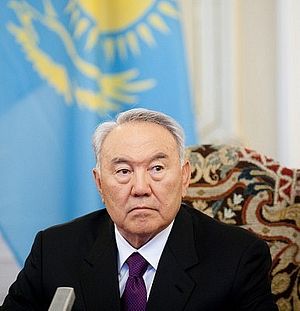Kazakhstan’s President Nursultan Nazarbayev finally made a public statement about the shoot-outs in Aktobe. He said the “terrorist attack” was the work of “followers of radical pseudo-currents” who received instruction from abroad. The statement rhetorically–though not explicitly–linked the violence in Aktobe with the recent Land Code protests and warned the Kazakh people about the risks of a color revolution.
As EurasiaNet commented after the speech, which was televised, “The speech presents the extraordinary prospect that the authorities may look to conflate — maybe even in their investigations and criminal trials — the ostensibly political protests and Aktobe, which is being cast so far as an act of Islamic terrorism.”
Nazarbayev’s statement argued that somebody was testing the state’s strength, exploiting the country’s “liberal public policies and laws.” He then directly referenced the much-feared color revolutions:
“We all know that the so-called ‘color revolutions’ use a variety of different methods and begin with contrived rallies, murder and the desire to seize power. These methods have manifested themselves in our country. In countries where these revolutions succeeded, there is no longer a working state and stability, only rampant poverty and banditry that create conditions for the emergence of extremists and terrorists. The economies of these countries have gone backwards by many years.”
In Central Asia, fear of color revolutions drives many government conversations about the rare instances of violence and unrest — that or Islamic extremism. The characterization of the color revolutions in the post-Soviet space in the early 2000 is colored by where one stands. In the West, the color revolutions (particularly Georgia’s 2003 Rose Revolution, Ukraine’s 2004 Orange Revolution, and Kyrgyzstan’s 2005 Tulip Revolution) are framed as popular uprisings in response to entrenched and corrupt leaders. In Russia, the color revolutions have been described as a form of subversive warfare–with the implication that the United States, in particular, not just inspires but finances them. In November 2014, Russian President Vladimir Putin warned of the risk: “In the modern world extremism is being used as a geopolitical instrument and for remaking spheres of influence. We see what tragic consequences the wave of so-called color revolutions led to.”
Central Asia’s longtime leaders look to Kyrgyzstan, Ukraine, and Georgia as examples of instability and connect that perceived instability with democracy-pushing nongovernmental organizations and influencers from abroad–rather than the persistence of autocratic systems.
That Nazarbayev’s language so closely matches that of Putin is of little surprise. The color revolutions, after all, swept from power leaders Moscow liked and threatened (though largely failed) to instill systems that would upset the status quo in the region. And while the countries that had color revolutions have had significant problems since, Nazarbayev’s characterization is extreme.
Surely neighboring Kyrgyzstan would be surprised to learn it does not have a working state. The point on instability is closer to the mark, as Kyrgyzstan experienced a second revolution in 2010, but despite both revolutions the country has remained generally stable. Neither revolution created the feared space for extremism to take root. And on the economic front, while Kyrgyzstan’s economy leaves much to be desired–as does its poverty rate–it has nonetheless grown since the color revolution. In 2005, Kyrgyzstan’s GDP sat at $2.4 billion and by 2013 it had risen to $7.2 billion.
Ukraine’s is more likely the color revolution Nazarbayev had in mind when making his speech. But there, still, the characterization is amiss. The government in Kyiv might contest the allegation that it does not have a working state. The point on stability is more meaningful, as Ukraine is torn by separatism in the east and the 2014 annexation of Crimea by Russia. But many of the players at the outset of the current troubles were the same as those that had a role in 2004. In the Western view, the crisis has stronger roots in the incompleteness of democratic reforms following 2004–allowing corrupt systems to persist–while the Russian view sees Western boogeymen instigating trouble.
Back to Kazakhstan. As I noted yesterday, the country has experienced unprecedented protests and violence this year. The Land Code protests and the events in Aktobe are not necessarily related, though the government looks likely to make that connection in the coming weeks. Astana is casting about for someone to blame for public frustration and thus feeding well-established rumors about nefarious foreign influencers plotting trouble on the steppe. The only place Astana doesn’t seem to be looking is in the mirror.
































